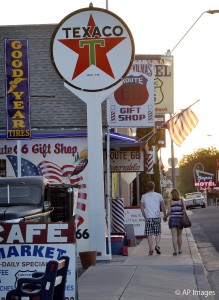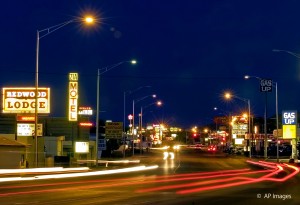As the Disney-Pixar movie Cars explains, there was once a thoroughfare through the southwestern United States that weaved from Chicago to Los Angeles through small towns, prairie and open desert. For most travelers, Route 66 was simply the best route west to California, one immortalized in John Steinbeck’s The Grapes of Wrath as the “Mother Road” the Joad family took to flee poverty during the Great Depression of the 1930s.
Route 66 embodies a nostalgic place and time, before the advent of the U.S. interstate highway system in the late 1950s, when a road-trip experience was more than a test of how long drivers could endure scenery flashing by at 110 kilometers per hour until, wearily, they must pull off for food and a place to sleep.Unlike today’s interstate highways, which bypass places where Americans actually live and work, Route 66 took motorists into the heart of America, with kitschy motels advertised by neon signs, Indian trading posts, and oddly named bars and restaurants. As part of the journey, the long-distance traveler experienced the local culture, and that culture achieved a connection with the outside world.

Profile Angel of Route 66 (©AP images)
Interest in old Route 66 has spiked, even outside the United States, among those who see the journey itself as the goal, not simply a means to a destination. Luckily, nearly 80 percent of the old route still exists, and many now seek to preserve the wonder of a road trip that takes the traveler off the beaten path.
Those searching for the “Real America” — the regional accents, local culinary treats, and the generous people happy with things just as they are — can find it on Route 66.
The first North American transcontinental automobile journey was completed in 1903 by a gentleman wealthy enough to own a vehicle, his mechanic and a bulldog named Bud, considerately equipped with his own goggles. It was not a pleasant journey.
The record shows it took 63 days to drive between California and Vermont, but it neglects to mention the days spent digging the car out of muddy horse trails, fording rivers and waiting in towns for trains to bring replacement parts. By the time more Americans could afford an automobile, Route 66 offered a paved and friendlier path west.
“It should not be denied that being footloose has always exhilarated us. It is associated in our minds with escape from history and oppression and law and irksome obligations. Absolute freedom. And the road has always led west,” said Christopher McCandless, who inspired the book and film Into the Wild.
The very act of travel symbolizes coming of age and self-realization, and the unknown element of it: not knowing whom you will meet, what experiences you will have, and what you will see. It drives today’s pioneers to the open road. Many of them now come to the United States to travel what was once the main route west to the paradise known as California.
The route’s founder, Cyrus Avery, in 1926 saw that when eastern residents of the United States arrived at St. Louis, the traditional outfitting and supply point going west, the best way onward to the Pacific Coast was to follow his southwestern trail, through small towns in Kansas, Oklahoma, Texas, Arizona, New Mexico, Nevada and, ultimately, California.
Businesses soon thrived along the route, with eager owners of restaurants, gasoline stations and motels taking advantage of the steady stream of new customers and competing to lure their business.
Today’s motorists can follow the Joads’ harsh journey or the carefree path of the film Easy Rider along the parts of Route 66 that remain in service. They can still see motels, restaurants and even gas stations that might have catered to those earlier travelers.
Route 66 is no longer the most efficient route west for drivers, but it offers a glimpse into a previous world, when traveling meant exploration, rather than simply a means to an end.








COMMENTS1
六本木でHo’okipaSquareとゆうライブ&イベントハウスをやっている三島と申します。
http://www.hookipasquare.com
10月29日㈫夜7時からルート66を語る会を開催します。
主催者は米国在住でルート66をFacebookで紹介してる日下部眞理子さん、今回はご主人でルート66の案内本を書いている画家のJerry McClanahanさんもご一緒です。
https://www.facebook.com/events/511380396332547/
ルート66がお好きな方、興味をお持ちの方、企業でご商売を繋げておられる方々などにお知らせしています。
ご興味あればご参加下さい。
三島
ホオキパスクエア
LEAVE A COMMENT
TOP